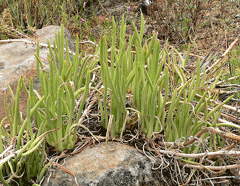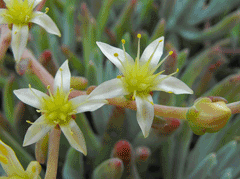 |
|
http://commons.wikimedia.org/wiki/User:Stan_Shebs |
 |
|
Translate this page:
Summary
Physical Characteristics

 Dudleya edulis is an evergreen Perennial growing to 0.5 m (1ft 8in).
Dudleya edulis is an evergreen Perennial growing to 0.5 m (1ft 8in).
See above for USDA hardiness. It is hardy to UK zone 8. It is in leaf all year, in flower from June to July. The species is hermaphrodite (has both male and female organs) and is pollinated by Insects.
Suitable for: light (sandy) and medium (loamy) soils and prefers well-drained soil. Suitable pH: mildly acid, neutral and basic (mildly alkaline) soils. It cannot grow in the shade. It prefers dry or moist soil and can tolerate drought.
UK Hardiness Map
US Hardiness Map
Synonyms
Cotyledon edulis. (Nutt.)Brewer.&Wats. Echeveria edulis. Stylophyllum edulis.
Plant Habitats
Cultivated Beds;
Edible Uses
Edible Parts: Leaves Stem
Edible Uses:
Leaves - raw. Fleshy[183]. They are considered to be a delicacy[183]. Stems - slightly sweet and refreshing to chew, though they leave a chalky taste in the mouth[183].
References More on Edible Uses
Medicinal Uses
Plants For A Future can not take any responsibility for any adverse effects from the use of plants. Always seek advice from a professional before using a plant medicinally.
None known
References More on Medicinal Uses
The Bookshop: Edible Plant Books
Our Latest books on Perennial Plants For Food Forests and Permaculture Gardens in paperback or digital formats.

Edible Tropical Plants
Food Forest Plants for Hotter Conditions: 250+ Plants For Tropical Food Forests & Permaculture Gardens.
More

Edible Temperate Plants
Plants for Your Food Forest: 500 Plants for Temperate Food Forests & Permaculture Gardens.
More

More Books
PFAF have eight books available in paperback and digital formats. Browse the shop for more information.
Shop Now
Other Uses
References More on Other Uses
Cultivation details
Requires a very sunny position in a well-drained soil[200]. Plants enter a semi-dormant state in late summer and they should be kept fairly dry at this time[200]. There must be some doubt over the hardiness of this species. One report says that it is hardy to zone 8 which suggests that it should tolerate occasional cold periods down to between -5 and -10°c, but the report also says that the plants should be protected from frost, with a winter temperatures no lower than 7°c[200].
References Carbon Farming Information and Carbon Sequestration Information
Temperature Converter
Type a value in the Celsius field to convert the value to Fahrenheit:
Fahrenheit:
The PFAF Bookshop
Plants For A Future have a number of books available in paperback and digital form. Book titles include Edible Plants, Edible Perennials, Edible Trees,Edible Shrubs, Woodland Gardening, and Temperate Food Forest Plants. Our new book is Food Forest Plants For Hotter Conditions (Tropical and Sub-Tropical).
Shop Now
Plant Propagation
Seed - we have no details for this species but suggest sowing the seed in spring in a greenhouse. When they are large enough to handle, prick the seedlings out into individual pots and grow them on in the greenhouse for at least their first winter. Plant them out into their permanent positions in late spring or early summer, after the last expected frosts. Cuttings of side shoots in the summer. Dry the stem for 24 hours before planting in a very sandy soil mix[200]. The main stem can also be used, the parent plant will then produce new plantlets at the cut edge[200].
Other Names
If available other names are mentioned here
Native Range
NORTHERN AMERICA: United States (California (southwest)), Mexico (Baja California (Norte) (northwest))
Weed Potential
Right plant wrong place. We are currently updating this section.
Please note that a plant may be invasive in one area but may not in your area so it's worth checking.
Conservation Status
IUCN Red List of Threatened Plants Status :

Growth: S = slow M = medium F = fast. Soil: L = light (sandy) M = medium H = heavy (clay). pH: A = acid N = neutral B = basic (alkaline). Shade: F = full shade S = semi-shade N = no shade. Moisture: D = dry M = Moist We = wet Wa = water.
Now available:
Food Forest Plants for Mediterranean Conditions
350+ Perennial Plants For Mediterranean and Drier Food Forests and Permaculture Gardens.
[Paperback and eBook]
This is the third in Plants For A Future's series of plant guides for food forests tailored to
specific climate zones. Following volumes on temperate and tropical ecosystems, this book focuses
on species suited to Mediterranean conditions—regions with hot, dry summers and cool, wet winters,
often facing the added challenge of climate change.
Read More
Expert comment
Author
(Nutt.)Moran.
Botanical References
71200
Links / References
For a list of references used on this page please go here
Readers comment